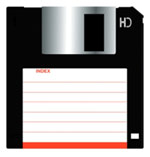If you still have your resume safely stored away on a floppy disk, you may want to think about converting it soon. In the very near future, you won't be able to purchase a floppy disk, let alone a floppy drive.
The time has come to bid farewell to one of the PC's more stalwart friends - the floppy disk. Computing superstore PC World said it will no longer sell the storage devices, affectionately known as floppies, once existing stock runs out.
New storage systems, coupled with a need to store more than the 1.44 megabytes of data held by a standard floppy, have led to its demise.
Only a tiny percentage of PCs currently sold still have floppy disk drives.
"The floppy disk looks increasingly quaint and simply isn't able to compete," said Bryan Magrath, commercial director of PC World.
Iconic status
It is not the first time the death-knell for the floppy has been sounded. The first nail in the coffin came in 1998, when the iMac was revealed without a floppy disk drive.
Then in 2003, Dell banished disk drives from its higher spec machines.
In 1998, an estimated 2 billion floppy disks were sold, according to the Recording Media Industries Association of Japan.
Since then global demand has fallen by around two-thirds to an estimated 700 million by 2006.
Only 2% of PCs and laptops currently sold by PC World still have built-in floppy disk drives and by the summer it will phase even these out.
It is with mixed feelings that the computer store has decided call time on the floppy.
"The sound of a computer's floppy disk drive will be as closely associated with 20th Century computing as the sound of a computer dialling into the internet," said Mr Magrath.
But with computer users increasingly using the internet or USB memory sticks - some of which store 2,000 times the capacity of the floppy disk - to transfer data, it is becoming redundant.
It is a far cry from its halcyon days in the 1980s and 1990s, when floppies provided essential back-up as well as playing a crucial role in transferring data and distributing software.
Shrinking disk
The first floppy disk was introduced in 1971 by IBM and heralded as a revolutionary device.
The brainchild of a group of Californian engineers led by Alan Shugart, it replaced old-fashioned punch-cards.
An eight-inch plastic disk coated with magnetic iron oxide, the nickname "floppy" came from its flexibility.
In 1976 the disk shrank to five-and-a-quarter inches - developed again by Alan Shugart, this time for Wang Laboratories.
By 1981, Sony shrank it some more - this time to three-and-a-half inches - the standard used to this day.
By the early 1990s, the growing complexity of software meant that many programs were distributed on sets of floppies. But the end of the decade saw software distribution swap to CD-ROM.
Vista icon
Alternative backup formats, new storage such as the CD-RW and the arrival of mass internet access, consigned the floppy disk to the dusty corner of peoples' desks and, eventually, the bin.
For those in the industry, there is little to mourn in the loss of floppy disks.
"You can get so much more information on other forms of storage. Technology moves on," said Bryan Glick, editor of Computing.co.uk.
But, he said, its demise, could prove problematic for those who have stored precious data on disk.
"There will be shops where they can get the data transferred but it they still have the original data they would be advised to invest in a portable hard drive or put it online," he said.
Interestingly, software giant Microsoft seems to be keeping the flame alight for the floppy.
Its newly-released operating system Vista still pays homage to it by continuing to use a floppy disk as the icon for saving a document in Microsoft Word 2007.
Source: BBC News

.jpg?t=1533315998368) How-To Articles
How-To Articles Support Portal
Support Portal Webmail
Webmail Rapid Newsletter+
Rapid Newsletter+ eCMS
eCMS


